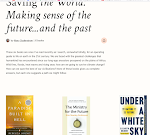There are 475 parking spaces at the Beaconsfield commuter train station, and when I was there at noon earlier this week the lot was about three-quarters full. Wonder if it will be fuller this morning, when people are supposed to leave their cars at home on the fifth annual “In Town without My Car” day.
Beaconsfield is a suburb on the western part of Montreal island, developed in the 1960s and 1970s as an up-scale community of single-family houses. There is some rental housing, and new development of town houses, but its 19,194 residents (2006 census) live mostly on lots of 100 by 100 in the best suburban style. There are some bicycle trails running through parks and along the St. Lawrence waterfront, but this is car country.
Should you decide to take the "no car" challenge and go into central Montreal by public transport this morning, though, you have two choices.
You can take the
train ($20.50 for a strip of six tickets, $5.25 the single ticket) at 6:14, 6:55, 7:20, 7:35, 7:54, 8:09, 8:34 or 8:40 a.m. and then transfer to the Métro at the Lionel-Groulx Métro station which will take you downtown. Time: maybe 45 minutes from the train station to the corner of Saint Catherine and Peel.
Or you can take the 221
Bus from the Beaconsfield train station, which will take you to the Métro at Lionel-Groulx. Time to Saint Catherine and Peel: something more than an hour with 15 departures between 6:14 and 9:30 .m. Cost: $11.75 for a six tickets, $2.75 single fare,
Either one will require a certain amount of coordination of schedules, and a walk from the downtown Métro station to your final destination. You may well end up saving money and time, however. Parking downtown runs at least $10 a day, and you must add the cost of operating your car on top of that—say a minimum of 35 cents a kilometer for a distance of 26 kilometers times two or about $18. Mapquest says the trip should take 23 minutes, but that’s certainly not the time at rush hour.
In today’s
La Presse, columnist Patrick Lagacé says that if we were really serious about trying to cut down on cars in cities we’d charge more for bringing cars into them instead of spending a lot of money on hoopla like a no-car day. If you pay more, you’ll opt for a cheaper solution, he says. He's probably right.
But it looks to me that people already aren’t doing the math when it comes to the relative costs of taking public transport. If they did, they’d decided it was cheaper: a minimum of $20 a day for transport by car versus $11.50 for the train and Métro or--even better--$5.50 for bus and Métro.
Jacking up the cost may help a bit, but just as important is guaranteeing that you don’t have to spend a half hour figuring out what buses to take, or have to wait too long if you miss your train or bus by a couple of seconds. To make increased service economically feasible will require more public financial support for transit—and also construction of a denser housing.
 A little rain and the asters bloom in the woods. Last year, when August was wet and I was walking every day across the mountain, I remember seeing clouds of them at the edge of wild spaces. This year it has been considerably drier and they only began to bloom after a good rain we had two weeks ago. Now they are everywhere.
A little rain and the asters bloom in the woods. Last year, when August was wet and I was walking every day across the mountain, I remember seeing clouds of them at the edge of wild spaces. This year it has been considerably drier and they only began to bloom after a good rain we had two weeks ago. Now they are everywhere.














